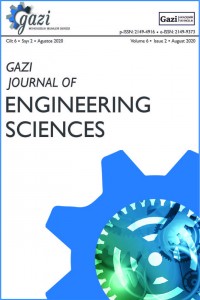Abstract
Yoğurt, yüksek besin değerleri ve sağlığa olan faydaları ile bolca tüketilen önemli bir süt ürünüdür. Yoğurdun üretiminden son kullanıcıya sunulmasına kadar kalitesine etki eden birçok üretim parametresi bulunmaktadır.Kaliteli ve standartlara uygun bir yoğurt üretimi için sağım sonrası elde edilen sütlerin belirli aşamalardan geçmesi gerekmektedir.Yoğurdun üretim aşamaları ve koşulları, üretim sonucu yoğurtta istenilen tat, tekstürel doku, renk, kıvam gibi kalite özelliklerini etkilemektedir. Her aşama, kendi içerisinde üretim sonucu oluşacak ürüne farklı şekillerde etkileri olmaktadır. Bu çalışmada besin değeri ve lezzeti ile çok önemli bir yere sahip olan yoğurdun tüm üretim ve tüketiciye sunum aşamasına kadar olan işlem basamakları incelenmiş; bu kapsamında,her üretim parametresi ve aşaması için hem teorik olarak hem de uygulama odaklı meydana gelebilecek kalite kayıpları açıklanmış ve kalite kayıplarının azaltılması için alınabilecek önlemler belirtilmiştir. Bu çalışma ile üretim aşamalarında yoğurt kalitesini ve üretimde verimliliği arttıracağı düşünülen önlemler paylaşılmıştır.
Supporting Institution
TÜBİTAK TEYDEP
Project Number
TübitakTeydep3190190
Thanks
Desteklerinden dolayı TÜBİTAK’a teşekkür ederiz.
References
- [1] Kalyenci, R (2019), Yoğurdun Faydaları Nelerdir? ,https://www.Memorial.Com.Tr/Saglik-Rehberleri/Yogurdun-Faydalari-Nelerdir/, Erişim Tarihi 16 Mart 2020.
- [2] T.C. Millî Eğitim Bakanlığı (2011), Gıda Teknolojisi Yoğurt, Ankara, Sayfa 10-11, 25, 40, 42, 48, 58
- [3] Anonim, (2009). Türk Gıda Kodeksi Fermente Süt Ürünleri Tebliği, Tebliğ No: 2009/25
- [4] Herdem, A., (2006), Farklı Yörelerden Toplanan Geleneksel Yöntemle Üretilen Yoğurt Örneklerinin Bazı Niteliklerinin Belirlenmesi, Yüksek Lisans Tezi, Selçuk Üniversitesi, Fen Bilimleri Enstitüsü, Gıda Mühendisliği Anabilim Dalı, Konya.
- [5] Karahan, L.E., (2016), Batman’da Tüketime Sunulan Yoğurtların Bazı Kimyasal ve Tekstürel Özellikleri, Batman Üniversitesi, Yaşam Bilimleri Dergisi, Cilt 6 Sayı 2/2, Sayfa 64
- [6] Sfakianakis, P., Tzia, C., (2014), Conventional and Innovative Processing of Milk for Yogurt Manufacture; Development of Texture and Flavor: A Review. Foods, 3(1), 176–193.
- [7] Akıncıoğlu, N., (2007), Yüksek Basınçta Homojenizasyon İşleminin Karıştırılmış Yoğurdun Yapısal Özelliklerine Etkisi, Yüksek Lisans Tezi, İstanbul Teknik Üniversitesi, Fen Bilimleri Enstitüsü, Sayfa 14-15, 18
- [8] MudawiH.A.,Abdelrahim S. M. K,(2014) Effect of Incubation and Storage Temperatures on Quality of Set Yoghurt, Egyptian Academic Journal of Biological Sciences C. Physiology&Molecular Biology.
- [9] Afonso, I.M.,Maia, J.M, (1999), Rheological Monitoring of Structure Evolution and Development in Stirred Yoghurt, Journal of Food Engineering, 42, 183- 190.
- [10] Atamer, M., Sezgin, E., (1987), İnkübasyon Sonu Asitliğinin Yoğurt Kalitesi Üzerine Etkisi, Ankara Üniversitesi Ziraat Fakültesi Süt Teknolojisi Ana Bilim Dalı, Ankara, Sayı 4
Abstract
Yoghurt is an important dairy product that is consumed abundantly with its high nutritional values and health benefits. There are many production parameters that affect the quality of yoghurt until it is presented to the end-user from the production. In order to produce high quality yoghurt, milks obtained after milking must pass certain stages. The production stages and conditions of yoghurt affect the desired quality features such as taste, texture texture, color, consistency. Each stage has different effects on the product that will occur as a result of production. In this study, the processing stages of yoghurt, which has a very important place with its nutritional value and taste, thew hole production process were examined; in this context, quality losses that may occur both theoretically and application-oriented for each production parameter and stage are explained and the preventıons that can be taken to reduce quality losses are specified. With this study, the preventıons that are thought to in crease the yoghurt quality and productivity in the production stages is shared.
Project Number
TübitakTeydep3190190
References
- [1] Kalyenci, R (2019), Yoğurdun Faydaları Nelerdir? ,https://www.Memorial.Com.Tr/Saglik-Rehberleri/Yogurdun-Faydalari-Nelerdir/, Erişim Tarihi 16 Mart 2020.
- [2] T.C. Millî Eğitim Bakanlığı (2011), Gıda Teknolojisi Yoğurt, Ankara, Sayfa 10-11, 25, 40, 42, 48, 58
- [3] Anonim, (2009). Türk Gıda Kodeksi Fermente Süt Ürünleri Tebliği, Tebliğ No: 2009/25
- [4] Herdem, A., (2006), Farklı Yörelerden Toplanan Geleneksel Yöntemle Üretilen Yoğurt Örneklerinin Bazı Niteliklerinin Belirlenmesi, Yüksek Lisans Tezi, Selçuk Üniversitesi, Fen Bilimleri Enstitüsü, Gıda Mühendisliği Anabilim Dalı, Konya.
- [5] Karahan, L.E., (2016), Batman’da Tüketime Sunulan Yoğurtların Bazı Kimyasal ve Tekstürel Özellikleri, Batman Üniversitesi, Yaşam Bilimleri Dergisi, Cilt 6 Sayı 2/2, Sayfa 64
- [6] Sfakianakis, P., Tzia, C., (2014), Conventional and Innovative Processing of Milk for Yogurt Manufacture; Development of Texture and Flavor: A Review. Foods, 3(1), 176–193.
- [7] Akıncıoğlu, N., (2007), Yüksek Basınçta Homojenizasyon İşleminin Karıştırılmış Yoğurdun Yapısal Özelliklerine Etkisi, Yüksek Lisans Tezi, İstanbul Teknik Üniversitesi, Fen Bilimleri Enstitüsü, Sayfa 14-15, 18
- [8] MudawiH.A.,Abdelrahim S. M. K,(2014) Effect of Incubation and Storage Temperatures on Quality of Set Yoghurt, Egyptian Academic Journal of Biological Sciences C. Physiology&Molecular Biology.
- [9] Afonso, I.M.,Maia, J.M, (1999), Rheological Monitoring of Structure Evolution and Development in Stirred Yoghurt, Journal of Food Engineering, 42, 183- 190.
- [10] Atamer, M., Sezgin, E., (1987), İnkübasyon Sonu Asitliğinin Yoğurt Kalitesi Üzerine Etkisi, Ankara Üniversitesi Ziraat Fakültesi Süt Teknolojisi Ana Bilim Dalı, Ankara, Sayı 4
Details
| Primary Language | Turkish |
|---|---|
| Journal Section | Research Articles |
| Authors | |
| Project Number | TübitakTeydep3190190 |
| Publication Date | August 25, 2020 |
| Submission Date | June 17, 2020 |
| Acceptance Date | August 8, 2020 |
| Published in Issue | Year 2020 Volume: 6 Issue: 2 |



